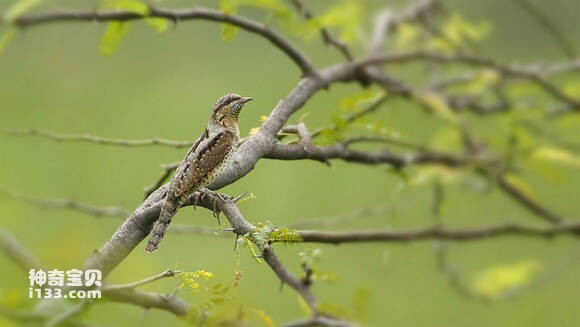Jynx torquilla
IUCN
LCBasic Information
Scientific classification
- name:Jynx torquilla
- Scientific Name:Jynx torquilla,Eurasian wryneck
- Outline:Climbing birds
- Family:
Vital signs
- length:16-19 centimeters
- Weight:28-47g
- lifetime:There are currently no research materials available
Feature
Distribution and Habitat
Ants are distributed in Afghanistan, Albania, Algeria, Andorra, Austria, Azerbaijan, Bahrain, Bangladesh, Belarus, Belgium, Bosnia and Herzegovina, Bulgaria, Burkina Faso, Cameroon, Chad, China, Cotdiva, Croatia, Cyprus, Czech Republic, Denmark, Djibouti, Egypt, Eritrea, Estonia, Ethiopia, Finland, France, Gambia, Georgia, Germany, Ghana, Gibraltar, Greece, Guinea Bissau, Hungary, India, Iran, Saudi Arabia, Iraq, Israel, Italy, Japan, Jordan, Kazakhstan, Kenya, South Korea, Democratic People's Republic of Korea, Spain, United Kingdom, United States, Canada, Thailand, Myanmar, Vietnam Mauritania, Senegal, Uganda, Tunisia, Finland, Russia, Turkmenistan, Norway, Sweden, Türkiye, Romania, Ukraine.
In China, it is distributed in western Xinjiang, Inner Mongolia, Heilongjiang, Jilin, Liaoning, Hebei, Gansu, Ningxia, Qinghai, Sichuan and southern Xizang, migrated to southern Liaoning, southwest, southern Hebei, Shandong, Shanxi, Shaanxi and other places, and wintered in the Yangtze Ri
Appearance
Ants are small birds with a body length of 16-19 centimeters. The forehead and head are dirty gray, mixed with black thirsty thin horizontal spots and gray white end spots. The remaining parts of the upper body are gray brown, with brown wings and brown insect like spots on both sides. There are thick and wide black longitudinal stripes on the pillow, back neck, and upper back, mixed with thirst gray, forming large ginger shaped spots. Shoulder feathers and tertiary flight feathers also have black longitudinal stripes, with white spots on the edges. The outer flight feathers are light black brown, with light chestnut square patches on the outer side and a series of gray brown triangular patches on the inner side. The tail is relatively soft, with a circular end and a color of marble silver gray or brown gray. It has 3-4 black horizontal spots, interspersed with black brown horizontal spots and insect like spots. Mouth straight, small and weak. Ear feathers chestnut brown, mixed with bl
Details
The scientific name of the ant beetle is Jynx torquilla, and the foreign name is Eurasian wryneck. There are six subspecies.

Ants often move alone, except in pairs during the breeding period. They often forage on the ground and move forward in a jumping manner when walking. Flying quickly and agile, often suddenly taking off and then suddenly descending, with mysterious movements. When resting, it often inhabits low and small trees or shrubs, and can also stand upright on tree trunks without moving for a long time. It can grab the trunk with its claws and move diagonally. Although ants spend a lot of time on branches, they sometimes inhabit low shrubs and grasslands. Due to its similarity in body color to dry grass or sandy soil on the ground, it is easy to conceal and its sound is often heard without its trace, hence it is also known as the "surface bird". The head is very agile and can twist in all directions when frightened, hence the name "crooked neck". During the breeding period, the chirping is frequent, with a short and sharp sound that resembles a "ga ga ga". Ants have extremely special feeding equipment - the tongue - to catch ants on the ground or in tree holes. When the ant beetle finds the ant hole, it extends its tongue into the ant hole, then sticks it like an ant, and then pulls it out. This is a characteristic of the tongue of an ordinary woodpecker. The tongue of an ant beetle is very long and has thorny hairs, and the sticky mucus secreted by the salivary glands at the base of the mouth covers the surface of the tongue. With light contact with prey, it is easy to capture them alive. Their diet mainly consists of ants, ant eggs, and pupae, as well as some small beetles.

The breeding period of ant beetles is from May to July. Paired by the end of April. Nesting in tree holes or abandoned woodpecker holes, as well as natural caves on decaying trees and tree stumps, and even on building walls and hollow cement pillars. Each litter lays 5-14 eggs, mostly 7-12. Egg white, oval or long oval in shape, measuring 22-24 millimeters x 15-17 millimeters, weighing 3-4 grams. Male and female take turns incubating eggs, with an incubation period of 12-14 days. The chicks are late bloomers, and the male and female parents raise their chicks together. After 19 to 21 days of feeding, the chicks can leave the nest and fly. Most of the migratory birds north of the Yangtze River in China are summer birds, while those south of the Yangtze River are winter birds or migratory birds. In spring, it moves to the breeding ground from April to May, and in autumn, it moves away from the breeding ground from September to October.

Listed in the 2016 IUCN Red List of Endangered Species ver 3.1- Least Concerned (LC).
Listed in the 2000 List of Beneficial or Important Terrestrial Wildlife under National Protection by the State Forestry Administration of China.
Protect wild animals and eliminate wild game.
Maintaining ecological balance is everyone's responsibility!








